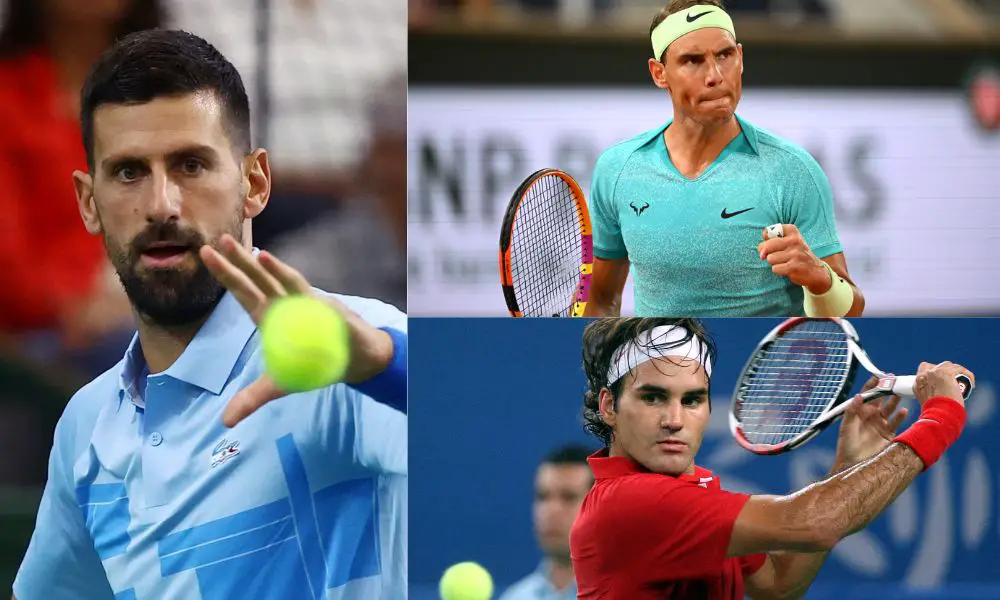The Magnitude of Earning the Grand Slam
In the realm of tennis, Grand Slam contests define the acme of achievement. These four landmarks – the Australian Open, French Open (Roland Garros), Wimbledon, and the US Open – have given the competing ground for tennis grandeur from time immemorial. From sweltering, scorching Melbourne to the toilsome-like clay courts of Paris, from the grass of Wimbledon to the hallucinating electric atmosphere of New York.
Before Federer, Nadal, and Djokovic, Pete Sampras’s 14 Grand Slam wins were a high mark that seemed impossible to achieve. No one could have speculated that an era would see the feat achieved by not one but three extraordinary athletes. They didn’t just surpass records; they completely altered the paradigm of what one thought was possible in tennis.
The Evolving Excellence of Grand Slam
| Year | Roger Federer | Rafael Nadal | Novak Djokovic | Defining moment |
| 2010 | 16 | 9 | 1 | Nadal Completes Career Slam |
| 2015 | 17 | 14 | 10 | Djokovic’s breakthrough year |
| 2020 | 20 | 20 | 17 | Historic three-way race |
| 2025 | 20 | 22 | 24 | Djokovic sets all-time record |
Scripting Their Way to Greatness
Roger Federer: The Early Ruler
The development of Roger Federer into tennis immortality began in the early 2000s and can remain forever referred to by many as the so-called golden age of tennis. It was at Wimbledon in 2003 that he made his first great breakthrough, thriving completely on the grass with his elegant play. From 2004 to 2007, he defined a level of dominance unparalleled: winning 11 of the 16 Grand Slams.
The athleticism of a young Federer was startling in its marketplace-to-market consistency. While he made Wimbledon his fortress, winning it eight times, he also conquered the Australian Open six times and the US Open five times. The French Open, one of the hardest tournaments played on clay, proved a tough nut to crack for him; however, in 2009, he achieved the elusive title, paving the way to career Grand Slam glory.
Rafael Nadal: The Clay Court Revolutionary
When Rafael Nadal started to make waves in tennis, the sport was preparing for a new dimension to its journey. His opportunities came only because he would go on to create the most enduring legacy any player ever created at a given Grand Slam: Roland Garros, featuring 14 titles on the hallmark of total and uncontested mastery of the surface.
Yet this was only part of Nadal’s metamorphosis. He won on all surfaces- two Australian Opens, two Wimbledons, and four US Opens. Even more remarkably, he went from being a clay court specialist to finishing as a serious challenger on all courts, a sign of his great adaptability and progress.
Novak Djokovic: The Record Breaker
Perhaps Djokovic had the hardest journey toward Grand Slam greatness, managing to dislodge the seeming invincibility of both Federer and Nadal. He rose to that level immediately after 2011, buoyed by his extraordinary ability to remain steady and last at 24, forever stretching the all-time Grand Slam record in that fashion.
Mastering the Australian Open with a perfect ten titles is similar to Nadal’s mastery of the Roland Garros. Another facet in which Djokovic excels is his everlasting consistency in all majors: He has the unique distinction of being one of the few players who has won each Grand Slam at least three times.
Surface Mastery and Specialization
Hard Court Dominance
Along with the US Open and the Australian Open, the most rigorously competitive tussles took place in these three tournaments. Djokovic’s grasp of the Australian Open (10) made him special, while Federer displayed utter mastery of a perfect five in succession at the US Open. For multiple titles on both these surfaces, Nadal showed himself equally versatile.
Clay Court Supremacy
Roland Garros became synonymous with the only Rafael Nadal, whose 14 titles constitute the most supreme display at a major. With only Federer (2009) and Djokovic (2016, 2021) able to claim the title during Nadal’s peak years, one can imagine the magnitude of his accomplishment.
Grass Court Excellence
The grand grass courts of Wimbledon gave rise to Federer’s artistic blend, which he excelled in with eight titles. Djokovic later matched this excellence on grass, while Nadal’s two titles proved he could adapt his play extremely well to the fast surface.
The Grand Slam Race: Momentous Events
2009: Federer’s Career Slam
Federer’s French Open achievement was the career-defining moment that enabled him to complete his Career Grand Slam, becoming the sixth man to accomplish this feat. It also marked his 15th major title, driving him beyond Pete Sampras’s record of 14 titles and cementing his assertion of becoming one of the greatest legends in the history of tennis.
2020: A Three-Way Tie
Rafael Nadal won his 20th Grand Slam title at the 2020 edition of the French Open, equaling Roger Federer for the all-time record for most Grand Slam titles-was a historic moment in the history of tennis. It marked the first time in men’s tennis history that two players were tied at the top for major wins.
This balance turned in 2021 when Novak Djokovic reached his 20th Grand Slam title, framing cry-like scenarios: the existence of an unprecedented three-way tie. Nadal’s victory was therefore not just another title but rather an important milestone with which we cement his legacy and the Big Three’s achievement in their “GOAT” debate.
2025: Djokovic Finally Did It
Djokovic’s rise to 24 Grand Slams capped an epic journey. From just one major in 2010, his slow but steady collection of titles in a consistently bleak cycle attests to unprecedented longevity.
Legacy and Impact
These three champions have rewritten the possibilities in tennis. Their collective achievements include:
- Age of three players to win 20+ Slams.
- The difficult era of competition and excellence.
- A rise in prestige for every major tournament.
- A well-rounded game that progresses on every surface.
The rivalry sharpened each of their games:
- Federer became more aggressive from the baseline.
- Nadal improved his game on hard and grass courts.
- Djokovic got better at serving and volleying.
Grand Slam Tennis in the Future
These three champions have set a new baseline for tennis excellence. Their peers will henceforth be measured against:
- Consistent performance across all surfaces.
- Mental tenacity to excel in five-set matches.
- Physical endurance to last through one’s career.
- Tactical flexibility to adapt against various styles of play.
While their records may eventually fall, their collective imprint on Grand Slam tennis shall forever change the sport. They demonstrated that, alone, specialization wouldn’t give players greatness; one truly has to be excellent in all conditions and surfaces.
The era of the three of them symbolizes not merely statistical achievement but the perfecting of tennis to greater heights of fitness and tactical superiority. Their legacy should inspire generations to come, while their aggregation of Grand Slam honors is a tribute to what can be done in tennis.

